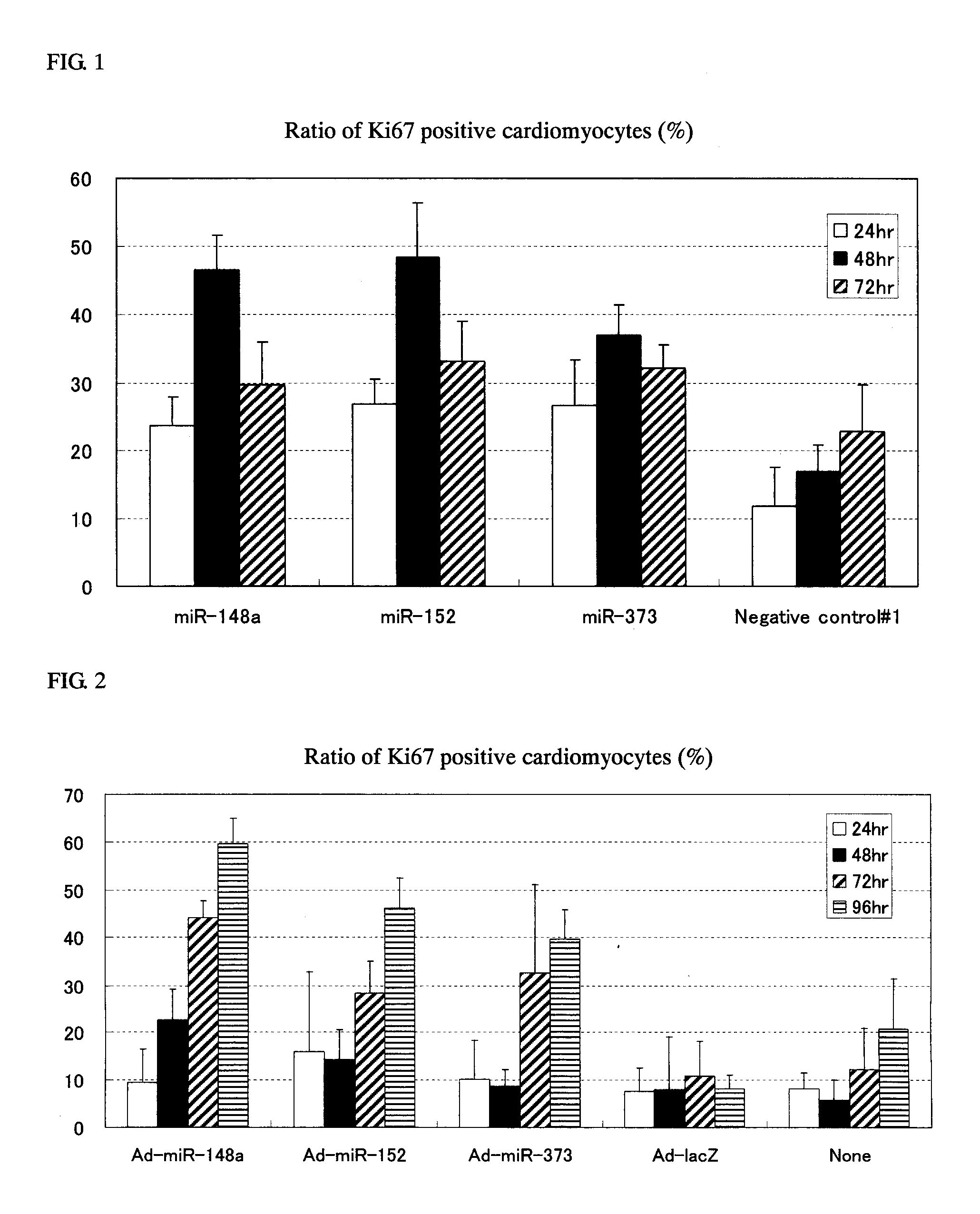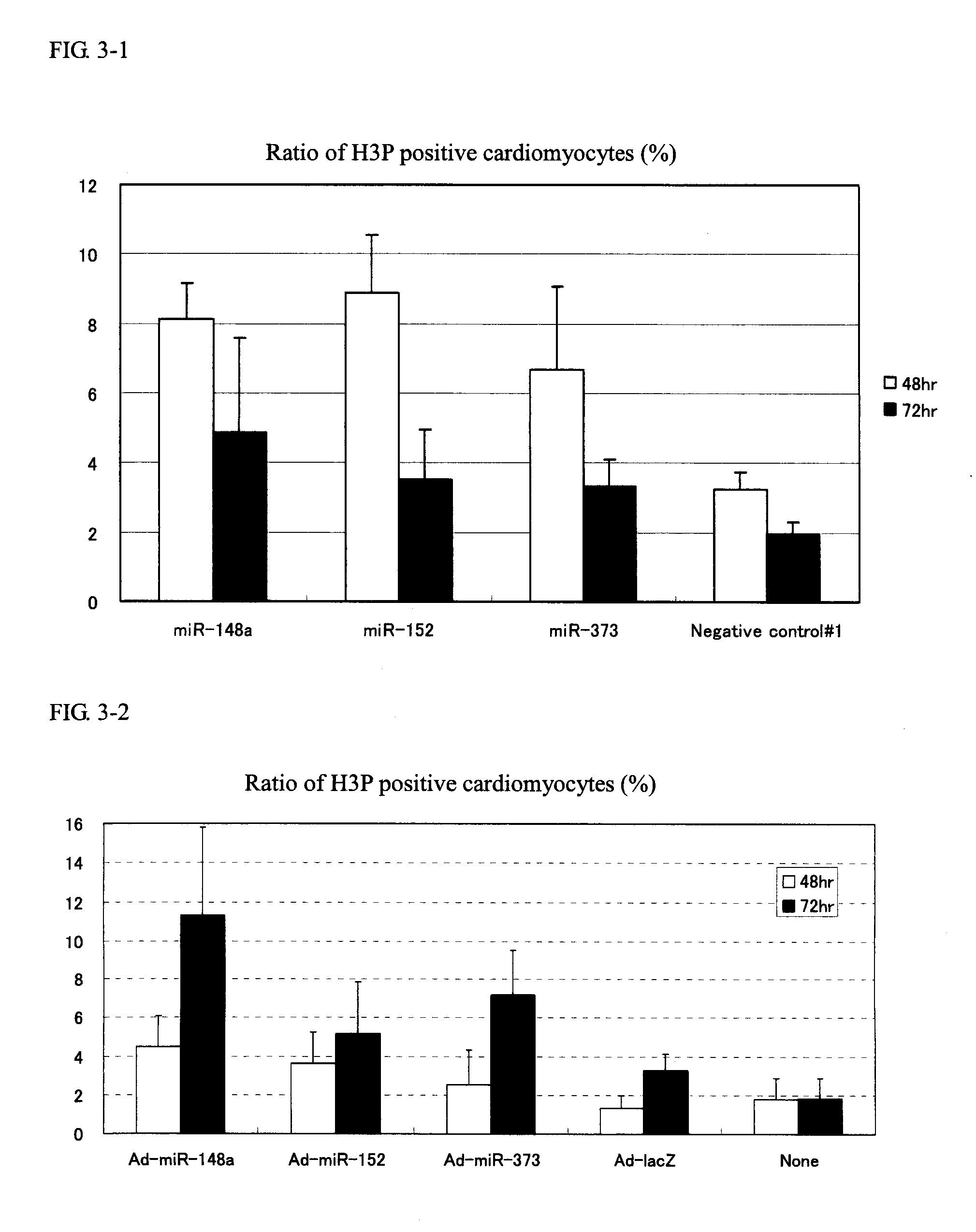Method for proliferating cardiomyocytes using micro-rna
a cardiomyocyte and micro-rna technology, applied in the field of proliferating cardiomyocytes using micro-rnas, can solve the problems of further exhaustion and death of cardiomyocytes, poor prognosis of patients with heart disease, and consequent impairment of myocardial function, and achieve the effect of marked proliferation activity
- Summary
- Abstract
- Description
- Claims
- Application Information
AI Technical Summary
Benefits of technology
Problems solved by technology
Method used
Image
Examples
example 1
BrdU-Uptake-Based Screening of miRNA Library Using Primary Culture of Cardiomyocytes
[0099]The heart was excised from 2-4 day old rats (Wistar rats obtained from SHIMIZU Laboratory Supplies Co., Ltd.) and treated with collagenase to prepare a cell population, from which cardiomyocyte fractions were recovered by Percoll density gradient centrifugation (a Percoll suspension of cells with a density of 1.082 g / mL was layered on a Percoll solution with a density of 1.050 g / mL or 1.060 g / mL, and subjected to centrifugation at 4° C. and 3000 rpm (2000 G) for 25 minutes). The thus obtained cardiomyocytes were suspended in an Eagle minimum medium (nakalai tesque) supplemented with 5% fetal calf serum (FCS; SAFC Bioscience) and then seeded on culture dishes for cell culture in a CO2 incubator at 37° C. The thus prepared cardiomyocytes (15,000 cells / well on a 96-well plate) were transfected with 2 pmol each of Pre-miR™ miRNA Precursor Library-HumanV2 (Ambion: a library designed to mimic the 328...
example 2
Analysis of a Marker for the Progress of Cell Cycle by Forced miRNA Expression in Primary Culture of Cardiomyocytes
[0100]Cardiomyocytes (100,000 cells / well on a 24-well plate) were transfected with 1 pmol of Pre-miR miRNA Precursor Molecules (Ambion) that were designed to mimic miR-148a, miR-148b, miR-152 and miR-373 (the candidate mature miRNAs obtained in Example 1) and 1 pmol of Negative control #1 (a negative control, also available from Ambion) using Lipofectamine™ RNAiMAX (Invitrogen) and 2-4 days after the transfection, the cells were fixed with 4% paraformaldehyde.
[0101]Following subsequent reaction with anti-Ki67 antibody (Thermo SCIENTIFIC) (1:200 dilution) and anti-Troponin T antibody (Thermo SCIENTIFIC) (1:200 dilution), the cells were stained with Alexa Fluor™ labeled antibody (Alexa-488 or Alexa-568; Molecular Probes) (both 1:400 dilutions). The cell nucleus was stained with a 4,6-diamidine-2′-phenylindole dihydrochloride: DAPI) solution (1 μg / mL).
[0102]The cardiomyocy...
example 3
Analysis of a Marker for the Progress of Cell Cycle by Adenovirus-Forced miRNA Expression in Primary Culture of Cardiomyocytes
[0105]Adenoviral vector for expressing miR-148a, miR-152, and miR-373 were prepared by using ViraPower™ Adenoviral Expression System (Invitrogen). To be more specific, human genomic DNA fragments comprising the precursor sequences of the respective miRNAs and adjacent several hundred nucleotides were amplified by PCR using the primers shown below, with the template being human genomic DNAs.
hsa-miR-148a-F:(SEQ ID NO: 11)5′-caccgaacacacctgcaggaagaaact-3′hsa-miR-148a-R:(SEQ ID NO: 12)5′-gttcccatttacagggtttaaccca-3′hsa-miR-152-F:(SEQ ID NO: 13)5′-caccgtcccagactcggctcccatca-3′hsa-miR-152-R:(SEQ ID NO: 14)5′-actcgaggtggacaccctgtgt-3′hsa-miR-373-F:(SEQ ID NO: 15)5′-caccgtgaccaaggggctgtatgca-3′hsa-miR-373-R:(SEQ ID NO: 16)5′-ctgcccaccccagaatatgcca-3′.
[0106]The resulting PCR products were inserted into a pENTR / D-TOPO vector (Invitrogen) and after checking their base s...
PUM
| Property | Measurement | Unit |
|---|---|---|
| density | aaaaa | aaaaa |
| density | aaaaa | aaaaa |
| density | aaaaa | aaaaa |
Abstract
Description
Claims
Application Information
 Login to View More
Login to View More - R&D
- Intellectual Property
- Life Sciences
- Materials
- Tech Scout
- Unparalleled Data Quality
- Higher Quality Content
- 60% Fewer Hallucinations
Browse by: Latest US Patents, China's latest patents, Technical Efficacy Thesaurus, Application Domain, Technology Topic, Popular Technical Reports.
© 2025 PatSnap. All rights reserved.Legal|Privacy policy|Modern Slavery Act Transparency Statement|Sitemap|About US| Contact US: help@patsnap.com



